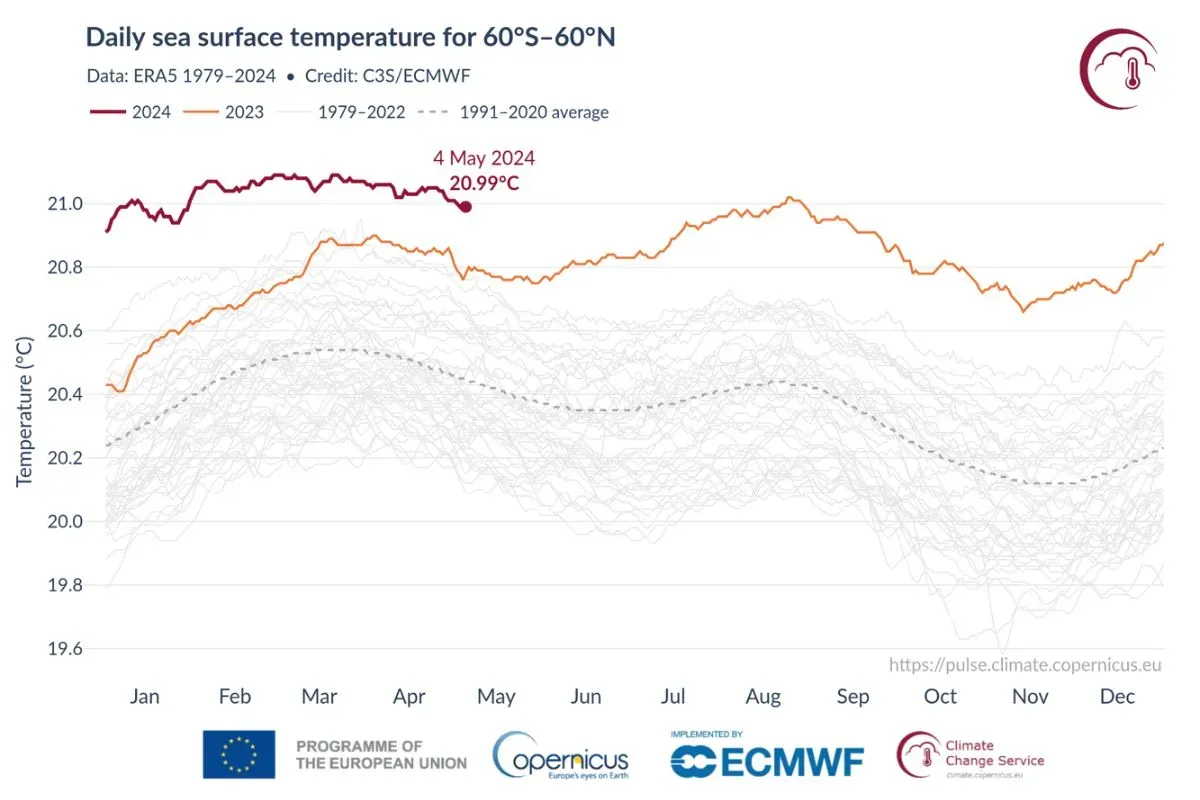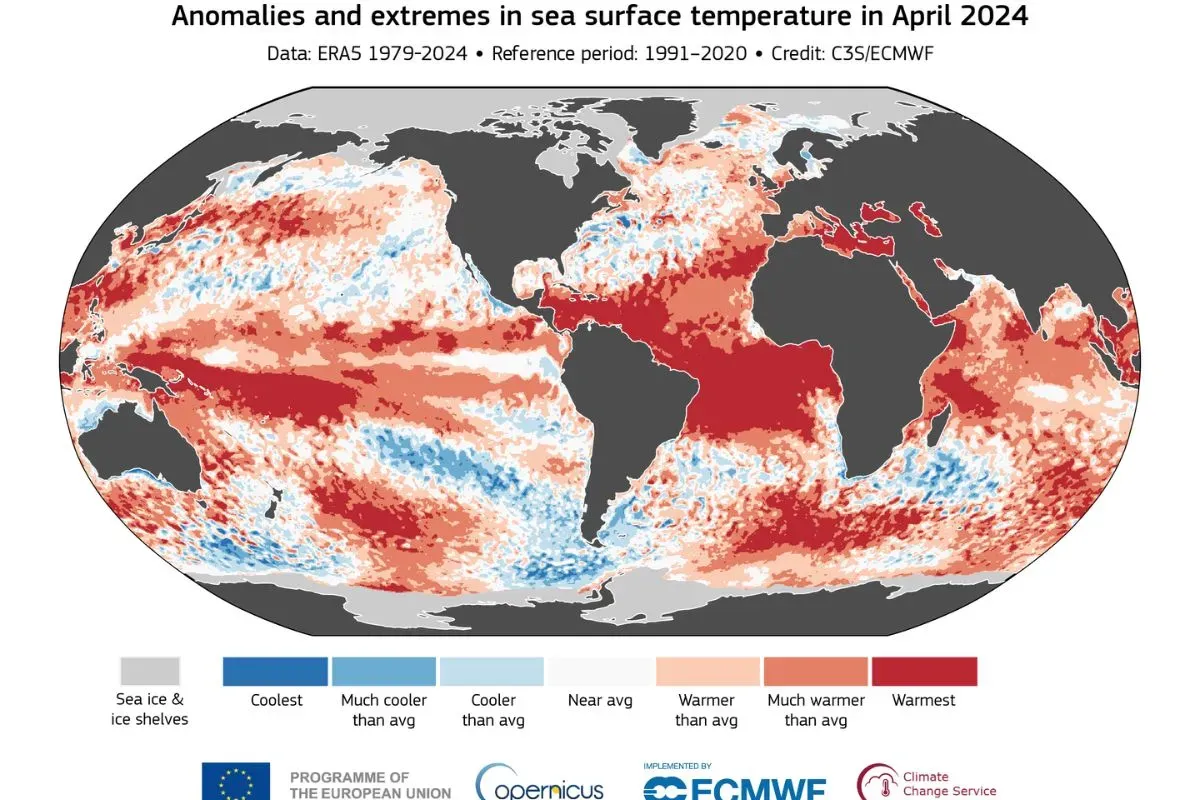April 2024 has continued the concerning trend of record global heat, marking the 11th consecutive month of unprecedented warmth. This signals a clear indication that humanity is facing unprecedented challenges in terms of climate change. However, there is some optimism that planetary temperatures may begin to stabilize soon, although they are expected to remain significantly higher than historical norms due to human-induced global warming.
“If 2024 continues to follow its expected trajectory, global temperatures will fall out of record territory in the next month or two,” Zeke Hausfather, a climate scientist with the payments company Stripe, wrote in a newsletter.
Earth has its warmest April
The surface air temperature record, April 2024 saw an average global temperature of 15.03°C, surpassing all previous Aprils on record. This temperature was 0.67°C above the April average for the period from 1991 to 2020 and 0.14°C higher than the previous record set in April 2016.

Monthly global surface air temperature anomalies (°C) relative to 1850–1900 from January 1940 to April 2024, plotted as time series for each year. 2024 is shown with a thick yellow line, 2023 with a thick red line, and all other years with thin lines shaded according to the decade, from blue (1940s) to brick red (2020s). Data source: ERA5. Credit: C3S/ECMWF.
This extended streak of record-breaking warmth follows a similar occurrence observed in 2015 and 2016, further emphasizing the persistent nature of rising global temperatures. Notably, April 2024 was a staggering 1.58°C warmer than the estimated average for the pre-industrial period from 1850 to 1900.
The concerning trend extends beyond a single month, with the average global temperature over the past 12 months (May 2023 – April 2024) reaching unprecedented levels. This period recorded a temperature anomaly of 0.73°C above the 1991-2020 average and a staggering 1.61°C above the pre-industrial benchmark.
Europe, too, felt the heat in April, with temperatures soaring 1.49°C above the April average for the period from 1991 to 2020. While ranking as the second warmest April on record for the continent, the month witnessed considerable temperature disparities across different regions. Eastern European areas experienced the most significant deviations from average temperatures, while Fennoscandia and Iceland saw below-average conditions.
Carlo Buontempo, Director of the Copernicus Climate Change Service (C3S), “El Niño peaked at the beginning of the year and the sea surface temperatures in the eastern tropical pacific are now going back towards neutral conditions. However, whilst temperature variations associated with natural cycles like El Niño come and go, the extra energy trapped into the ocean and the atmosphere by increasing concentrations of greenhouse gases will keep pushing the global temperature towards new records.”
Beyond Europe, regions such as northern and northeastern North America, Greenland, eastern Asia, the northwest Middle East, parts of South America, and much of Africa also experienced temperatures well above average.

Daily sea surface temperature (°C) averaged over the extra-polar global ocean (60°S–60°N) for 2023 (orange) and 2024 (dark red). All other years between 1979 and 2022 are shown with grey lines. The daily average for the 1991–2020 reference period is shown with a dashed grey line. Data source: ERA5. Credit: Copernicus Climate Change Service/ECMWF
While the El Niño event in the eastern equatorial Pacific weakened towards neutral conditions, marine air temperatures remained unusually high, contributing to the overall warming trend. Global sea surface temperatures (SST) for April 2024 set a new record, averaging 21.04°C over the 60°S–60°N latitude band, slightly below the previous month’s record of 21.07°C.
April 2024: Varied weather, polar ice changes
April 2024 brought notable hydrological patterns across various regions globally. In Europe, northwestern, central, and northeastern areas experienced above-average precipitation, while southern regions, including parts of Spain, Italy, the Balkans, Türkiye, Ukraine, and southern Russia, were drier than usual. Similarly, wetter conditions prevailed in parts of North America, Central Asia, the Persian Gulf countries, easternmost Asia, eastern Australia, and southern Brazil, leading to instances of flooding.
Conversely, drier-than-average conditions were observed in northern Mexico, around the Caspian Sea, the Tibetan Plateau, and most of Australia.
Regarding sea ice, Arctic sea ice extent was slightly below average by about 2%, with concentrations remaining above average in the Greenland Sea. However, Antarctic sea ice extent was notably lower, marking the 10th lowest extent for April in satellite data records, with concentrations particularly diminished in the northern Weddell Sea and Ross-Amundsen Sea sector.

Global temperatures entering uncharted territory?
As we move into the coming months, all eyes are on whether global temperatures will revert to a more typical pattern after the fading of El Niño and the onset of La Niña conditions. The trajectory of temperatures in the latter half of 2023, which saw significant elevation, raises concerns about what lies ahead.
Should the latter part of 2024 resemble 2023, there’s a possibility that the year’s overall temperature could approach 1.6°C above pre-industrial levels. This scenario, as described by Gavin Schmidt in a recent Nature commentary, would thrust us into what he termed “uncharted territory” for our climate.
Keep Reading
Part 1: Cloudburst in Ganderbal’s Padabal village & unfulfilled promises
India braces for intense 2024 monsoon amid recent deadly weather trends
Support us to keep independent environmental journalism alive in India.
Follow Ground Report on X, Instagram and Facebook for environmental and underreported stories from the margins. Give us feedback on our email id greport2018@gmail.com.
Don’t forget to Subscribe to our weekly newsletter, Join our community on WhatsApp, and Follow our YouTube Channel for video stories.









